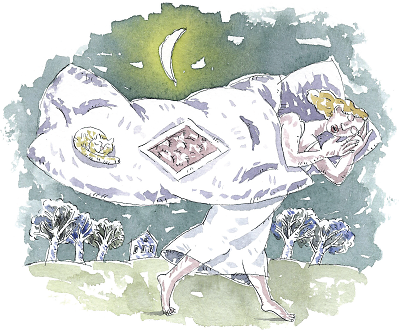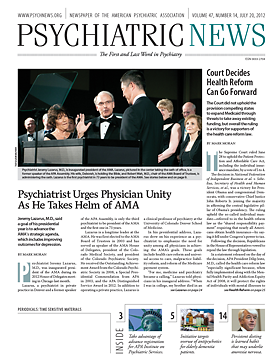Nearly 4 percent of American adults—roughly 8.5 million people—may have walked in their sleep last year, a study of nearly 16,000 adults suggests. Three in 10 adults surveyed reported sleepwalking at least once in their lives. Most said they had walked in their sleep for more than five years, often since childhood.
“Sleepwalking is far more prevalent in adults than previously thought,” Maurice Ohayon, M.D., D.Sc., Ph.D., a professor of psychiatry and behavioral science at Stanford University School of Medicine, and colleagues report in the May 15 Neurology (see Advice for Treating Patients Who Sleepwalk).
It probably has familial roots, said Ohayon, who directs Stanford’s Sleep Epidemiology Research Center. Nearly one-third of sleepwalkers reported having at least one other sleepwalker in the family.
People with major depressive disorder, obsessive-compulsive disorder, or alcohol abuse/dependence were more likely than people with no mental disorders to sleepwalk one or more times a year, the researchers found. These individuals were also more likely than people with other mental disorders to report sleepwalking two or more times a month.
People using selective serotonin reup-take inhibitor (SSRI) antidepressants and those using over-the-counter sleeping pills were more apt than nonusers of these medications to report sleepwalking in the previous year and at least two times a month. They sleepwalked before they started to use these medications, however. Non-SSRI antidepressants showed no significant association with sleepwalking. “Some medications may trigger or increase sleepwalking in people predisposed to it,” Ohayon told Psychiatric News.
“In the vast majority of cases, sleepwalking has no adverse consequences,” he added. In familiar surroundings, people seldom injure themselves and return to bed on their own or with help from a family member. But even a single case of someone walking outside or falling from a window, he noted, is cause for concern.
Ohayon and colleagues conducted hour-long telephone interviews with 15,929 Americans aged 18 and older in 15 states, a representative sample of the U.S. adult population. Respondents comprised over 83 percent of 19,136 eligible adults contacted.
Using a questionnaire designed for epidemiologic studies, researchers asked participants about their general health, sleep habits and disorders, mental health, and medication use. They assessed sleep disorders according to DSM-IV-TR and ICSD-II classifications, and mental disorders using DSM-IV-TR classifications.
Some 3.6 percent of respondents said they had walked in their sleep at least once in the prior year. About 2.6 percent reported one to 12 episodes during the prior year, and 1 percent reported two or more episodes a month. Sleepwalking was not associated with gender and declined with age, except in people who had episodes once a week. Since sleepwalking commonly involves complete or partial amnesia, Ohayon said, sleepwalking likely was underreported, especially by people living alone.
Researchers asked participants who described nocturnal wandering with impaired consciousness how often such episodes occurred and when they started. They also asked if sleepwalkers had trouble awakening from such episodes, confusion if awakened, and what they remembered.
“Contrary to popular belief, sleep and wakefulness are not mutually exclusive states,” Mark Mahowald, M.D., a coauthor of the report and a professor of neurology at the University of Minnesota Medical School, told Psychiatric News. “In sleepwalking episodes, part of the brain is awake and part is asleep simultaneously,” he said. “The part that is awake is capable of conscious awareness. The part that is asleep is not.”
Sleepwalking usually interrupts stage 3-4 nonrapid-eye-movement (NREM) sleep, not the REM stage in which most vivid dreams occur. Sleepwalkers tend to have less stable stage 3-4 sleep than nonsleepwalkers, Mahowald said.
Sleep deprivation and sleep fragmentation may trigger sleepwalking. In people with normal sleep, sleep deprivation consolidates sleep. In people predisposed to sleepwalking, sleep deprivation often makes sleep more fragmented, Mahowald noted. Participants who reported averaging less than seven hours of sleep a night were more likely to sleepwalk than those who usually slept longer.
Among participants with sleep disorders, those with obstructive sleep apnea syndrome, circadian rhythm sleep disorder, or insomnia disorder reported sleepwalking more often than people without these disorders. Some 4.1 percent of people with sleep apnea, for example, said they walked in their sleep two or more times a month, compared with 0.9 percent of participants without sleep apnea.
Sleep apnea causes frequent arousals. Recent studies show effective treatment for sleep apnea improves sleep continuity and ends the sleepwalking.
In the latest study, Ohayon and Mahowald collaborated with researchers at the Hôpital Gui-de-Chauliac in Montpellier, France, Duke University School of Medicine, and Université Paris Descartes in Paris, France.
Funding came from the National Institutes of Health, the Arrillaga Foundation, the Bing Foundation, and Neurocrines Biosciences.

Advice for Treating Patients Who Sleepwalk
Since 30 percent of American adults report current or past sleepwalking, ask all patients about a personal and family history of this experience, suggests Maurice Ohayon, M.D., Ph.D., director of the Stanford University Sleep Epidemiology Sleep Research Center and lead investigator of a recent study of sleepwalking (see Sleepwalking More Likely With Several Psychiatric Disorders).
In those with a positive history, particularly those with major depressive disorder, obsessive-compulsive disorder, or alcohol abuse/dependence, he said, avoid prescribing SSRI antidepressants, which may increase sleepwalking. Also, encourage patients to get sufficient sleep—that’s seven to eight hours for most adults.
Despite extensive media attention, instances of sleepwalking accompanied by complex behaviors such as driving, violence, and inappropriate sexual acts following sedative-hypnotic use are rare, said study coauthor Mark Mahowald, M.D., a professor of neurology at the University of Minnesota. When prescribing sedative-hypnotic medications, he advised, provide and review written instructions, warn patients about potential adverse effects, and monitor them closely.

